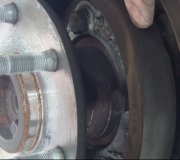Oh my. Tell me you're kidding! I've never considered what lacquer thinner is made from, but if any petroleum product gets into the brake fluid, the repair will be more expensive than the car is worth. Rather than retype a really long answer, here is a copy of a short version I've posted before. If I need to, I'll find the long and boring version with a lot more information. Remember, this was written to someone else, so just take from it what you can:
If the fluid is contaminated with petroleum product the car is probably not worth repair. The first clue is the rubber bladder seal under the reservoir cap will be blown up and mushy. All the rubber parts in the hydraulic system will be grown the same way. The lip seals inside the master cylinder will grow past the fluid return ports and block them. That keeps the trapped fluid under pressure and unable to return to the reservoir, and that keeps the brakes partially applied. The excessive heat buildup from driving the car like that makes the brake fluid get real hot and expand. Since the fluid is trapped, when it expands, it applies the brakes harder. Eventually the car will barely move and one or two wheels will get real hot, both symptoms you're describing now.
The only proper fix is to remove everything with rubber parts, flush and dry the steel lines, then install new parts. That includes replacing the new calipers and wheel cylinders, all rubber flex hoses, the combination valve, and the master cylinder. If any part, such as the new calipers, are left on the car, the contamination will leach out of the seals and recontaminate the new fluid.
Every week we read about someone who accidentally put power steering fluid, engine oil, or transmission fluid in the master cylinder but there are other ways to contaminate the fluid. One problem that was more common years ago was repacking front wheel bearings, then wiping hands on a rag, then reseating the bladder seal into the cap when refilling the master cylinder. The grease residue on fingertips is enough to contaminate the system.
Another problem showed up many years ago at a mass merchandiser. A new mechanic wiped out a funnel used for engine oil, then used it to fill a brake pressure bleeder ball. The residue in the funnel contaminated five gallons of brake fluid and many cars.
Experienced brake mechanics will even wash their hands with soap and water before touching any seal or other rubber parts they're working on. Also, they will never use penetrating oil to free up rusted fittings in the brake system.
Brake fluid can be contaminated with water too but that won't cause the rubber parts to swell. That will simply lower the boiling point from well over 400 degrees to closer to 212 degrees, and it will promote corrosion of metal parts but that's all. Moisture contamination comes from leaving the master cylinder cap off or the cap off the bottle of new fluid. Brake fluid sucks humidity out of the air, and it will absorb some over time in the car's hydraulic system.
Lets hope you don't find contaminated fluid. It's fairly common to find rust buildup inside crimp fittings and brackets on flex hoses restricting them so fluid can be pumped to a caliper but it takes a long time to release. Often the additional clue is the brake pedal is higher and harder than normal when you press it.
Monday, June 27th, 2016 AT 12:21 AM


